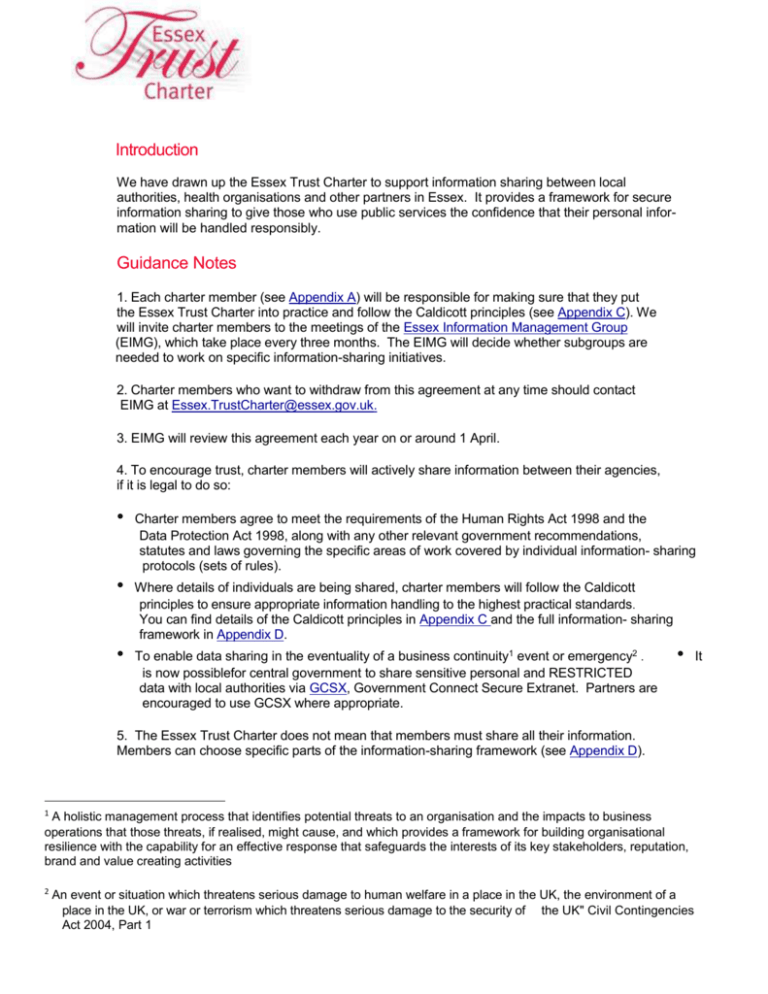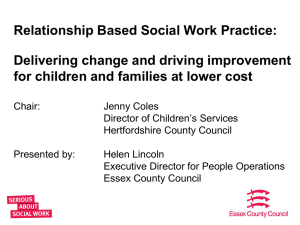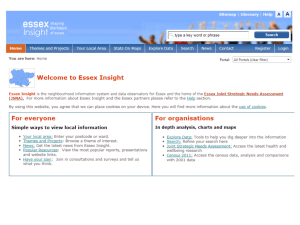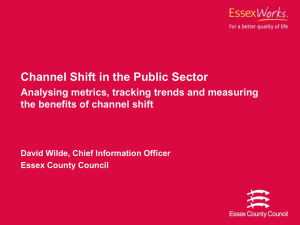ETCGuidance - Essex Partnership Portal
advertisement

Introduction We have drawn up the Essex Trust Charter to support information sharing between local authorities, health organisations and other partners in Essex. It provides a framework for secure information sharing to give those who use public services the confidence that their personal information will be handled responsibly. Guidance Notes 1. Each charter member (see Appendix A) will be responsible for making sure that they put the Essex Trust Charter into practice and follow the Caldicott principles (see Appendix C). We will invite charter members to the meetings of the Essex Information Management Group (EIMG), which take place every three months. The EIMG will decide whether subgroups are needed to work on specific information-sharing initiatives. 2. Charter members who want to withdraw from this agreement at any time should contact EIMG at Essex.TrustCharter@essex.gov.uk. 3. EIMG will review this agreement each year on or around 1 April. 4. To encourage trust, charter members will actively share information between their agencies, if it is legal to do so: • • • Charter members agree to meet the requirements of the Human Rights Act 1998 and the Data Protection Act 1998, along with any other relevant government recommendations, statutes and laws governing the specific areas of work covered by individual information- sharing protocols (sets of rules). Where details of individuals are being shared, charter members will follow the Caldicott principles to ensure appropriate information handling to the highest practical standards. You can find details of the Caldicott principles in Appendix C and the full information- sharing framework in Appendix D. To enable data sharing in the eventuality of a business continuity1 event or emergency2 . is now possiblefor central government to share sensitive personal and RESTRICTED data with local authorities via GCSX, Government Connect Secure Extranet. Partners are encouraged to use GCSX where appropriate. • 5. The Essex Trust Charter does not mean that members must share all their information. Members can choose specific parts of the information-sharing framework (see Appendix D). 1 A holistic management process that identifies potential threats to an organisation and the impacts to business operations that those threats, if realised, might cause, and which provides a framework for building organisational resilience with the capability for an effective response that safeguards the interests of its key stakeholders, reputation, brand and value creating activities 2 An event or situation which threatens serious damage to human welfare in a place in the UK, the environment of a place in the UK, or war or terrorism which threatens serious damage to the security of the UK" Civil Contingencies Act 2004, Part 1 It 6. Within legal limits, people have the right to: • see information that is stored about them; • comment on it; and • have their information treated with appropriate confidentiality The information to be shared under the agreement will fall into four categories. They are: [N.B. section 6 currently has only draft status] 7. For each subject area or information-sharing purpose, the charter member involved will develop a protocol. A Privacy Impact Assessment (PIA) enables members to analyse and highlight any privacy risks re- lating to data sharing and discuss possible solutions. This is an example of the PIA form used by ECC. The Information Commissioner’s Office provides further information. An information sharing protocol is used to document the decisions made when completing the PIA. It is an agreement between partners setting out the details of how the information will be shared. The standard format for a protocol is shown in Appendix E. Some protocols may be combined to develop a common protocol. Each protocol will be supported by procedures, which will be developed to suit all the members involved. Appe Appendix A - A list of charter members Essex Trust Charter signatories, known as Charter Members • • • • • • • • • • • • • • • • • • • • • • • • • • • • • • • • • • • • • Basildon and Thurrock University Hospital Basildon District Council Braintree District Council Brentwood Borough Council Castle Point Borough Council Chelmsford Borough Council Colchester Borough Council Colchester Hospital University NHS Foundation Trust Epping Forest District Council Essex Ambulance Service NHS Trust Essex County Council Essex Fire and Rescue Essex Police Essex, Southend & Thurrock Connexions Essex Strategic Health Authority Farleigh Hospice Harlow District Council Hertfordshire Partnership NHS Foundation Trust Maldon District Council Mid Essex Hospital Services NHS Trust Mid Essex Primary Care Trust National Childminding Association National Probation Service - Essex Area North East Essex PCT North Essex Foundation Partnership NHS Trust London and Quadrant Housing Trust Pre-School Learning Alliance Rochford District Council South East Essex PCT South Essex Partnership NHS Trust Southend Hospital NHS Trust Southend-on-Sea Borough Council South West Essex PCT Tendring District Council The Princess Alexandra Hospital NHS Trust Thurrock Borough Council Uttlesford District Council West Essex PCT Independent Schools • • • • • • • • • • • • • • • • • • • • • • • • • • Autism Anglia/Doucecroft School The Christian School (Takeley) Colchester High School The Daiglen School Dame Bradbury's School Donyland Lodge Essex Fresh Start The Felsted School FKS Schools Limitedt Guru Gobind Singh Khalsa College The Heathcote School Herington House School Holmwood House School Howe Green House School Loyola Preparatory School Maldon Court Preparatory School Oxford House School Peniel Academy The Ryes School St Cedds School St John's School St Mary's School Ursuline Preparatory School Widford Lodge School Woodcroft School The Yellow House School Further Education Colleges • • • • • • Braintree College Chelmsford College Colchester Institute Epping Forest College SEEVIC The 6th Form College Colchester Housing Associations • • • • • • • • • • Affinity Sutton East Potential Epping DC Housing Options Family Mosaic Greenfields Hastoe Housing Association In Touch South Anglia Housing Southern Housing Swan Group Appendix B - The Trust Charter, trust services and the law Much of the information and guidance you will need around the sharing of sensitive data and working with information as an organisation can be found on the Information Commissioner's website, www.ico.gov.uk. This includes their Framework code of practice for sharing personal information. 1. The main purpose of the Trust Charter is to give customers using public services confidence that their personal information is being handled appropriately. Security measures are provided through a three-tier structure: • Principles - the Trust Charter • Purposes • Processes - information-sharing protocols and individual procedures 2. Trust charters and information-sharing protocols must keep to the following legislation. • The Human Rights Act 1998 and the European Convention on Human Rights - sets out the individual's right to privacy in correspondence. • The Data Protection Act 1998 - sets out requirements for handling and protecting personal information that organisations hold. • The Electronic Communications Act 2000 - sets out the appropriate use of electronic signatures. • The Interception of Communications Act 1985 - makes it an offence to intercept calls on a public phone system without the knowledge of the caller, unless a legal case is put forward to do so within specific time limits. • The Regulation of Investigatory Powers Act 2000 - deals with the offence of interception and extends this to private networks. The Act also regulates access by employers to communications that their employees use. • The Wireless Telegraphy Act 1949 - controls the monitoring of radio transmissions. • The Police and Criminal Evidence Act 1984 - sets out the situations when the police are allowed to gather and use evidence from electronic communications. • The Computer Misuse Act 1990 - makes attempted or actual breaking into (or sabotaging) computer systems a criminal act. • The Public Records Act 1958 - sets out requirements for storing and maintaining documentary records of government activities. • The Official Secrets Act 1989 - sets out how government information is controlled. • The Freedom of Information Act 2000 - sets out the individual's rights of access to information held by local authorities and health authorities. • The Civil Contingencies Act 2004 - focuses on local arrangements for civil protection and emergency powers to deal with the effects of the most serious emergencies. 3. Information security standard ISO 27001 is a code of practice with details of what needs to be taken into account when setting up secure information communications technologies (ICTs) - that is, ways of sharing information over the internet or phone. These technical standards provide a set of controls to make sure best practice for trust services is followed. You can get information on the standards from the website of the British Standards Institute at www.global.com/index.xalter# Appendix C - Caldicott principles Principle 1: Justify the purposes Every proposed use or transfer of 'patient-identifiable or client-identifiable information' (where the individual can be identified) within or from an organisation should be clearly defined and inspected. Continuing uses should be regularly reviewed by an appropriate person (known as the Caldicott Guardian). Principle 2: Don't use patient-identifiable or client-identifiable information unless it is absolutely necessary Patient-identifiable or client-identifiable information should not be used unless there is no alternative. Principle 3: Use the minimum necessary patient-identifiable or client-identifiable information If using patient-identifiable or client-identifiable information is essential, each individual item of information should be justified with the aim of reducing the possibility of an individual being identified. Principle 4: Access to patient-identifiable or client-identifiable information should be on a strict need-to-know basis Only those individuals who need access to patient-identifiable or client-identifiable information should have access to it, and they should only have access to the information they need to see. Principle 5: Everyone should be aware of their responsibilities Action should be taken to make sure that those handling patient-identifiable or clientidentifiable information (clinical, non-clinical and non-health staff) are aware of their responsibilities to respect confidentiality of patients and clients. Principle 6: Understand and follow the law Every use of patient-identifiable or client-identifiable information must be legal. Someone in each organisation should be responsible for making sure that the organisation meets legal requirements. You can see the formal wording of the Caldicott principles at the DoH page on patient confidentiality and access to health records: http://www.dh.gov.uk/en/Managingyourorganisation/Informationpolicy/Patientconfidentialityand caldicottguardians/DH_4100563 Appendix D - Information-sharing framework This framework was based on central government guidance on trust charters Principle: A county-wide multi-agency overarching policy for sharing personal information. • • A single guiding policy to encourage trust among people in Essex and between charter members by providing a secure framework for information sharing. Strategic responsibility: Essex Information Management Group (EIMG) Purposes: To identify the reasons for Information Sharing Protocols (ISP). Processes: Detailed operational protocols for information sharing. • • Purpose: To allow both personalised and non-personalised information to be shared as set out in legislation. To specify the processes for sharing and receiving information in line with relevant protocols. Responsibility: These are multi-agency agreements and individual charter members involved are responsible for different areas. Each charter member will be responsible for their own procedures. Appendix E - Guidelines for protocols Each protocol should tackle all the areas listed below. 1 .Legal duties and legislation • • • • • • Common law Article 8 of the Human Rights Act Data Protection Act 1984 Data Protection Act 1998 Caldicott principles Other relevant legislation, as listed in Appendix B 2. Managing the protocols • • • • Defining the responsibility for the protocol Involving the Caldicott Guardians Relationship to the Essex Trust Charter Charter members involved 3. Sharing information • • • • • • • • • • • • • • General principles, including the main purpose Details of information and ways of sharing non-personal information Details of information and ways of sharing personal information Data controllers, as defined in the Data Protection Act Information security Confidentiality and privacy How much information will be shared and who with Using the shared information for purposes that are different from the purposes for which it was originally shared Quality of the information Documents Reviewing, holding on to and destroying information Getting permission How the information will be shared so that it works within the systems in each of the organisations involved Common set of terms and language Detailed guidance for the preparation of a data sharing protocol is available on the Essex Trust Charter website http://www.essexinformationsharing.gov.uk Appendix F - Personal information The Data Protection Act defines categories of sensitive personal data, that is, personal data made up of information on: a. the racial or ethnic origin of the 'data subject' (the person whose information it is); b. his or her political opinions; c. his or her religious beliefs, or other beliefs of a similar nature; d. whether he or she is a member of a trade union (within the meaning of the Trade Union and Labour Relations (Consolidation) Act 1992); e. his or her physical or mental health or condition; f. his or her sexual life; g. him or her committing, or allegedly committing, any offence; or h. any proceedings for any offence committed (or alleged to have been committed), how the proceedings are finalised, or the sentence of any court in proceedings. For the purposes of information-sharing under the Essex Trust Charter, non-sensitive personal information is information on individuals that is not defined in the Data Protection Act as sensitive Definitions GCSx GCSx is a government accredited secure communications channel which enables secure interactions between connected local authorities, central government departments and their agencies. EIMG Essex Information Management Group (EIMG) EIMG is a forum for the exchange of high level information and good practice, the joint resolution of problems and the sharing of intelligence in the information management arena. Terms of Reference Work collaboratively towards the provision of more effective information services for the community as a whole and for all partner agencies. Develop the Essex Trust Charter to support partnership arrangements for sharing information between organisations in a safe and secure manner. Investigate more cost-effective and efficient ways of acquiring, processing, disseminating and sharing information, including the use of Information Communications Technology (ICT) wherever appropriate. Work closely with the Essex Online Partnership Management Group to develop ICT capabilities in support of county wide service improvement initiatives that can benefit from programme and project management. Develop partnership arrangements for the provision of a countywide network of Geographical Information and National Census data. Build a community of practice to improve the way we all work with aggregated information and intelligence to provide better services. The EIMG convenes working groups as required to deliver specific objectives, within an agreed timescale and then disbands them. The EIMG reports to the Essex Chief Executives Association (ECEA) and the Joint Strategic Needs Assessment Steering Group (JSNA). Membership of the group to include: County Council Unitary Authorities District and Borough Councils DC and ECC Members Essex Online Partnership Fire and Rescue Health Authorities Police Shared Services Partnership Voluntary Sector Organisations




